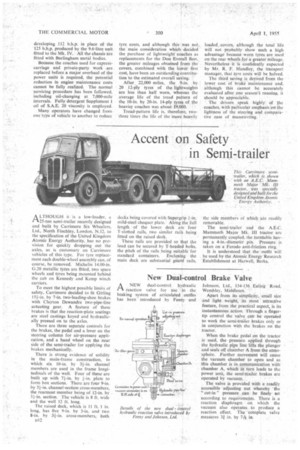Lightweight Coaches PROVE Their WORTH
Page 53

Page 54

If you've noticed an error in this article please click here to report it so we can fix it.
Promise of Longer Life and Less Need for Maintenance is Held Out by Coaches Based Upon Chassis Such as Those Purchased by Don Everall, Ltd.
WHEN the unladen weight of a goods vehicle is reduced, its payload capacity is increased by a corresponding amount, and there is generally no marked benefit in terms of running cost per mile. The formula that the lighter the vehicle the greater the payload has been accepted under duress by designers, who regard it as a technically unsound basis for development whatever the practical benefits may he and the advances that have been made to accommodate it.
A reduction in weight of a coach or bus chassis, on the other hand, is normally to enable approximately the same load to be carried more economically, and there is no implied contradiction of established technical values. Weight reduction as applied to passenger vehicles can therefore, academically and practically, be termed the start of a virtuous circle, unless the designer fails at his job.
The lower weight to be carried reduces the load not only on the power unit, but also on the tyres, the brakes, the steering gear and every chassis component, the size of which has not been scaled down proportionately. This gives promise of longer wearing life and reduced maintenance.
In 1951, Don Everall, Ltd., Cleveland Road. Wolverhampton, purchased a fleet of the most modern coaches then available for express-carriage and private-party work, to be run in conjunction with older vehicles engaged on works services and so on. The vehicles comprised 43-seaters of Leyland, A.E.C., Guy and Daimler manufacture.
The Leyland Royal Tigers and Daimler Freelines are fitted with Metalcraft composite bodies and have an unladen weight of over 8 tons; the A.E.C. Mk. IVs have Burlingham bodies and an unladen weight of nearly 84 tons. The Guy Arabs weigh only a fraction less than 8 tons. The Guys are also fitted with Metaleraft bodies.
These vehicles have been giving an excellent service and their average fuelconsumption rate of 12 m.p.g. is considered satisfactory. Following a decision in 1953, however, that they should be replaced by lightweight coaches to reduce running costs, a changeover to lightweight 41-seaters produced by the Leyland. A.E.C. and Guy companies was initiated in 1954, and a fleet Cif these vehicles was used throughout the holiday season.
The 14 vehicles in the new fleet each covered upwards of 20,000 miles in the season at an average of 15i m.p.g., and tyre wear was greatly reduced. For the combined mileage of well over 300,000, the saving in the fuel consumed was more than 5,500 gallons.
The 1954 fleet includes 10 Guy Arab lightweight coaches with an approximate unladen weight of 6 tons 12 cwt., two Leyland Tiger Cub coaches of 6 tons 4 cwt., and two A.E.C. Reliance coaches, of which the unladen weight is 5 tons 18 cwt. The Guy Arabs are powered by the Gardner 6LW unit with an output of 112 b.h.p., which is the same engine as that fitted to the former vehicles of this make, and the higher power-to-weight ratio benefits performance to a marked extent. The chassis are equipped with five-speed gearboxes with an overdrive top gear,
Despite a reduction in b.h.p. from 125 to 108, when comparing the outputs of the Leyland Royal Tiger and Tiger Cub units, the power-to-weight ratio of the latter vehicle also shows to advantage, and this applies to the A.E.C. Reliance coaches, the 7.7-litre engine developing 112 b.h.p. in place of the 125 b.h.p. produced by the 9.6-litre unit fitted to the Mk. IV. All the chassis are fitted with Burlingham metal bodies.
Because the coaches used for expresscarriage and private-party work arc replaced before a major overhaul of the power units is required, the potential reduction in engine maintenance costs cannot be fully realized. The normal servicing procedure has been followed, including oil-changing at 7,000-mile intervals. Fully detergent Supplement 1 oil of S.A.E. 20 viscosity is employed.
Many operators have changed from one type of vehicle to another to reduce
tyre costs, and although this was not, the main consideration which decided the purchase of lightweight coaches as replacements for the Don Everall fleet, the greater mileages obtained from the covers, combined with the lower first cost, have been an outstanding contribution to the estimated overall saving.
After, 22,000 miles, the 9-in. by 20 12-ply tyres of the lightweights are less than half worn, whereas the average life of the tread pattern of the 10-in. by 20-in. 14-ply tyres of the heavier coaches was about 19,000.
Tread-pattern life is, therefore, twothree times the life of the more heavily
loaded covers, although the total life will not probably show such a high advantage because worn tyres are used on the rear wheels for a greater mileage. Nevertheless it is confidently expected by Mr. R. F. Hundley, the transport manager, that tyre costs will be halved.
The third saving is derived from the lower cost of brake maintenance and, although this cannot be accurately evaluated after one season's running, it should be appreciable.
The drivers speak highly of the coaches, with particular emphasis on the lightness of the steering and comparative ease of manceuvring.




















































































































